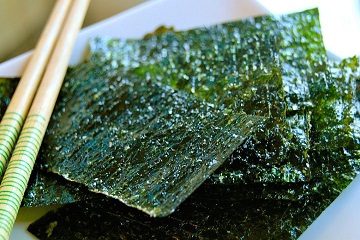IPB Students Created Inori Products from Local Seaweed

Seaweed is one of the most abundant export commodities in Indonesian waters with increasing production every year. Seaweed production in Indonesia reaches 10.2 million tons in 2014. Indonesian seaweed has an economic value and widely traded in the world. Grow wild or cultivated seaweeds can be used as food and medicine.
One country that has processed food from seaweed is Japan. Japan processes seaweed into several types of food, one of which is nori. Nori is a traditional Japanese food in the form of seaweed sheets consumed after being dried or roasted. Nori from Japan is originated from red seaweedPorphyra.
The existence of many Japanese restaurants in Indonesia makes high demand for nori to be imported. This is due to all consumed nori are still being imported from Japan, China and Korea. In addition, the utilization of Indonesian seaweed is still carried out by coastal communities close to the raw materials, so it has not been widely used. In addition, it has a low selling point in Indonesia.
This is what underlies a student named Laksmita Ayu Praphesti from the Department of Food Science and Technology, Faculty of Agricultural Technology, Bogor Agricultural University (Fateta IPB) to conduct a research to make nori from local seaweed mixture of Ulva lactuca andGlacilaria sp. She expected that this product can increase the selling value of Indonesian seaweed.
Ulva lactuca was chosen because it is easy to obtain and also abundant in the eastern coast of Indonesia. In addition, it contains high fiber so that the texture produced on this nori product will be able to match the commercial nori. Glacilaria sp was chosen because the agar contained inGlacilaria sp seaweed can be used as a binding agent on the sheet nori product to form a smooth and flat sheet.
The study consisted of two stages: inori formulation and inori characterization by organoleptic test, physical and chemical analysis. Inori was made from porridge of both seaweed mixtures. The porridge was made by separately smoothing the seaweed. There were two inori products namely spicy and baked inori. Organoleptic tests were performed on both of these products.
The results showed that seaweed species Ulva lactuca and Glacilaria sp can be utilized for local nori production. The best inori product based on hedonic rating test is baked inori. This inori product has low water and fat content with high total carbohydrate content. The best formula of mixed nori was by comparison of 1:1 seaweed porridge for each seaweed type with the dough weight per mold area of ??0.28 gram per square centimeter to adjust the thickness. In addition, the inori product has high fiber content as well as good chemical and physical characteristics. (TK).



